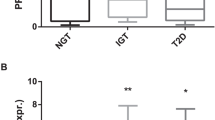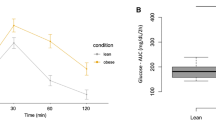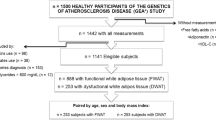Abstract
Background/Objectives:
OxLDL–β2GPI complex has been suggested to have a role in the development of atherosclerosis and other inflammatory diseases. The aim of this study was to investigate the possible association of circulating oxLDL–β2GPI with obesity-induced inflammatory state of adipose tissue and related comorbidities as metabolic syndrome development.
Subjects/Methods:
Two cohorts of subjects were examined in the study. Cohort I: 36 women with wide range of body mass index (17–48 kg m−2) and metabolic status (with or without metabolic syndrome (MS); cohort II: 20 obese women undergoing a dietary intervention (DI) consisting of 1-month very-low-calorie diet, and 5 months of weight-stabilization period. Serum levels of oxLDL–β2GPI were measured by enzyme-linked immunosorbent assay. Insulin sensitivity was evaluated by hyperinsulinemic-euglycemic clamp and homeostasis model assessment of insulin resistance. mRNA expression of macrophage markers was determined in both subcutaneous (SAT) and visceral (VAT) adipose tissue in cohort I and in SAT in cohort II.
Results:
Serum oxLDL–β2GPI levels were increased in obese subjects with MS compared to lean or obese without MS (obese with MS: 26.6±5.0 vs lean: 15.17±1.97, P<0.001; vs obese without MS: 16.36±2.89, P<0.05). Serum oxLDL–β2GPI correlated with MS indices (glucose, high-density lipoprotein, triglyceride and ureic acid) and with mRNA expression of macrophage markers in VAT. Weight-reducing DI decreased serum oxLDL–β2GPI levels together with lipid parameters and the mRNA expression of inflammatory markers in SAT.
Conclusions:
OxLDL–β2GPI seems to be an important marker of visceral adipose tissue inflammation and possibly a factor contributing to insulin resistance and metabolic syndrome development in obese patients.
This is a preview of subscription content, access via your institution
Access options
Subscribe to this journal
Receive 12 print issues and online access
$259.00 per year
only $21.58 per issue
Buy this article
- Purchase on Springer Link
- Instant access to full article PDF
Prices may be subject to local taxes which are calculated during checkout


Similar content being viewed by others
References
Daniele G, Guardado Mendoza R, Winnier D, Fiorentino TV, Pengou Z, Cornell J et al. The inflammatory status score including IL-6, TNF-alpha, osteopontin, fractalkine, MCP-1 and adiponectin underlies whole-body insulin resistance and hyperglycemia in type 2 diabetes mellitus. Acta Diabetol 2014; 51: 123–131.
Osborn O, Olefsky JM . The cellular and signaling networks linking the immune system and metabolism in disease. Nat Med 2012; 18: 363–374.
Holvoet P, Mertens A, Verhamme P, Bogaerts K, Beyens G, Verhaeghe R et al. Circulating oxidized LDL is a useful marker for identifying patients with coronary artery disease. Arterioscler Thromb Vasc Biol 2001; 21: 844–848.
Sanchez-Quesada JL, Vinagre I, De Juan-Franco E, Sanchez-Hernandez J, Bonet-Marques R, Blanco-Vaca F et al. Impact of the LDL subfraction phenotype on Lp-PLA2 distribution, LDL modification and HDL composition in type 2 diabetes. Cardiovasc Diabetol 2013; 12: 112.
Aranda N, Fernandez-Cao JC, Tous M, Arija V . Increased iron levels and lipid peroxidation in a Mediterranean population of Spain. Eur J Clin Invest 2016; 46: 520–526.
Frostegard J . Autoimmunity, oxidized LDL and cardiovascular disease. Autoimmun Rev 2002; 1: 233–237.
Liu J, Rosner MH . Lipid abnormalities associated with end-stage renal disease. Semin Dial 2006; 19: 32–40.
Mayr M, Kiechl S, Tsimikas S, Miller E, Sheldon J, Willeit J et al. Oxidized low-density lipoprotein autoantibodies, chronic infections, and carotid atherosclerosis in a population-based study. J Am Coll Cardiol 2006; 47: 2436–2443.
Frostegard J, Haegerstrand A, Gidlund M, Nilsson J . Biologically modified LDL increases the adhesive properties of endothelial cells. Atherosclerosis 1991; 90: 119–126.
Boullier A, Bird DA, Chang MK, Dennis EA, Friedman P, Gillotre-Taylor K et al. Scavenger receptors, oxidized LDL, and atherosclerosis. Ann N Y Acad Sci 2001; 947: 214–222 discussion 222-223.
Hasunuma Y, Matsuura E, Makita Z, Katahira T, Nishi S, Koike T . Involvement of beta 2-glycoprotein I and anticardiolipin antibodies in oxidatively modified low-density lipoprotein uptake by macrophages. Clin Exp Immunol 1997; 107: 569–573.
Kajiwara T, Yasuda T, Matsuura E . Intracellular trafficking of beta2-glycoprotein I complexes with lipid vesicles in macrophages: implications on the development of antiphospholipid syndrome. J Autoimmun 2007; 29: 164–173.
George J, Harats D, Gilburd B, Afek A, Levy Y, Schneiderman J et al. Immunolocalization of beta2-glycoprotein I (apolipoprotein H) to human atherosclerotic plaques: potential implications for lesion progression. Circulation 1999; 99: 2227–2230.
Greco TP, Conti-Kelly AM, Anthony JR, Greco Jr T, Doyle R, Boisen M et al. Oxidized-LDL/beta(2)-glycoprotein I complexes are associated with disease severity and increased risk for adverse outcomes in patients with acute coronary syndromes. Am J Clin Pathol 2010; 133: 737–743.
Lopez LR, Hurley BL, Simpson DF, Matsuura E . Oxidized low-density lipoprotein/beta2-glycoprotein I complexes and autoantibodies in patients with type 2 diabetes mellitus. Ann N Y Acad Sci 2005; 1051: 97–103.
Lopez LR, Simpson DF, Hurley BL, Matsuura E . OxLDL/beta2GPI complexes and autoantibodies in patients with systemic lupus erythematosus, systemic sclerosis, and antiphospholipid syndrome: pathogenic implications for vascular involvement. Ann N Y Acad Sci 2005; 1051: 313–322.
Kraml PJ, Syrovatka P, Potockova J, Andel M . The oxidized low-density lipoprotein/beta2-glycoprotein I complex is associated with abdominal obesity in healthy middle-aged men. Ann Nutr Metab 2013; 62: 7–13.
Arner P . Not all fat is alike. Lancet 1998; 351: 1301–1302.
Merlotti C, Ceriani V, Morabito A, Pontiroli AE . Subcutaneous fat loss is greater than visceral fat loss with diet and exercise, weight-loss promoting drugs and bariatric surgery: a critical review and meta-analysis. Int J Obes (Lond) 2017; 41: 672–682.
Montague CT, O'Rahilly S . The perils of portliness: causes and consequences of visceral adiposity. Diabetes 2000; 49: 883–888.
Alberti KG, Zimmet P, Shaw J, Group IDFETFC. The metabolic syndrome—a new worldwide definition. Lancet 2005; 366: 1059–1062.
Fujioka S, Matsuzawa Y, Tokunaga K, Tarui S . Contribution of intra-abdominal fat accumulation to the impairment of glucose and lipid metabolism in human obesity. Metabolism 1987; 36: 54–59.
DeFronzo RA, Tobin JD, Andres R . Glucose clamp technique: a method for quantifying insulin secretion and resistance. Am J Physiol 1979; 237: E214–E223.
Rossmeislova L, Malisova L, Kracmerova J, Tencerova M, Kovacova Z, Koc M et al. Weight loss improves the adipogenic capacity of human preadipocytes and modulates their secretory profile. Diabetes 2013; 62: 1990–1995.
Klimcakova E, Roussel B, Kovacova Z, Kovacikova M, Siklova-Vitkova M, Combes M et al. Macrophage gene expression is related to obesity and the metabolic syndrome in human subcutaneous fat as well as in visceral fat. Diabetologia 2011; 54: 876–887.
Garg PK, McClelland RL, Jenny NS, Criqui MH, Greenland P, Rosenson RS et al. Lipoprotein-associated phospholipase A2 and risk of incident cardiovascular disease in a multi-ethnic cohort: the multi ethnic study of atherosclerosis. Atherosclerosis 2015; 241: 176–182.
Liu J, Ren Y, Kang L, Zhang L . Oxidized low-density lipoprotein increases the proliferation and migration of human coronary artery smooth muscle cells through the upregulation of osteopontin. Int J Mol Med 2014; 33: 1341–1347.
Mangge H, Zelzer S, Puerstner P, Schnedl WJ, Reeves G, Postolache TT et al. Uric acid best predicts metabolically unhealthy obesity with increased cardiovascular risk in youth and adults. Obesity (Silver Spring) 2013; 21: E71–E77.
Berger JS, Rockman CB, Guyer KE, Lopez LR . Proatherogenic oxidized low-density lipoprotein/beta2-glycoprotein I complexes in arterial and venous disease. J Immunol Res 2014; 2014: 234316.
Esser N, Legrand-Poels S, Piette J, Scheen AJ, Paquot N . Inflammation as a link between obesity, metabolic syndrome and type 2 diabetes. Diabetes Res Clin Pract 2014; 105: 141–150.
Boden G . Fatty acid-induced inflammation and insulin resistance in skeletal muscle and liver. Curr Diab Rep 2006; 6: 177–181.
Zhang X, Xie Y, Zhou H, Xu Y, Liu J, Xie H et al. Involvement of TLR4 in oxidized LDL/beta2GPI/anti-beta2GPI-induced transformation of macrophages to foam cells. J Atheroscler Thromb 2014; 21: 1140–1151.
Sies H, Berndt C, Jones DP . Oxidative stress. Annu Rev Biochem 2017; 86: 715–748.
Anderson MT, Staal FJ, Gitler C, Herzenberg LA, Herzenberg LA . Separation of oxidant-initiated and redox-regulated steps in the NF-kappa B signal transduction pathway. Proc Natl Acad Sci USA 1994; 91: 11527–11531.
Flohe L, Brigelius-Flohe R, Saliou C, Traber MG, Packer L . Redox regulation of NF-kappa B activation. Free Radic Biol Med 1997; 22: 1115–1126.
Matsuura E, Lopez LR, Shoenfeld Y, Ames PR . beta2-glycoprotein I and oxidative inflammation in early atherogenesis: a progression from innate to adaptive immunity? Autoimmun Rev 2012; 12: 241–249.
Kuwana M, Matsuura E, Kobayashi K, Okazaki Y, Kaburaki J, Ikeda Y et al. Binding of beta 2-glycoprotein I to anionic phospholipids facilitates processing and presentation of a cryptic epitope that activates pathogenic autoreactive T cells. Blood 2005; 105: 1552–1557.
Amano SU, Cohen JL, Vangala P, Tencerova M, Nicoloro SM, Yawe JC et al. Local proliferation of macrophages contributes to obesity-associated adipose tissue inflammation. Cell Metab 2014; 19: 162–171.
Kralova Lesna I, Kralova A, Cejkova S, Fronek J, Petras M, Sekerkova A et al. Characterisation and comparison of adipose tissue macrophages from human subcutaneous, visceral and perivascular adipose tissue. J Transl Med 2016; 14: 208.
Kovacikova M, Sengenes C, Kovacova Z, Siklova-Vitkova M, Klimcakova E, Polak J et al. Dietary intervention-induced weight loss decreases macrophage content in adipose tissue of obese women. Int J Obes (Lond) 2011; 35: 91–98.
Viardot A, Lord RV . Samaras K. The effects of weight loss and gastric banding on the innate and adaptive immune system in type 2 diabetes and prediabetes. J Clin Endocrinol Metab 2010; 95: 2845–2850.
Capel F, Klimcakova E, Viguerie N, Roussel B, Vitkova M, Kovacikova M et al. Macrophages and adipocytes in human obesity: adipose tissue gene expression and insulin sensitivity during calorie restriction and weight stabilization. Diabetes 2009; 58: 1558–1567.
Antunes BM, Rossi FE, Cholewa JM, Lira FS . Regular physical activity and vascular aging. Curr Pharm Des 2016; 22: 3715–3729.
Lin N, Shi JJ, Li YM, Zhang XY, Chen Y, Calder PC et al. What is the impact of n-3 PUFAs on inflammation markers in type 2 diabetic mellitus populations?: a systematic review and meta-analysis of randomized controlled trials. Lipids Health Dis 2016; 15: 133.
Acknowledgements
The work was supported by grant 16-14048S from the Grant Agency of Czech Republic, and by Projects PRVOUK P31 and UNCE 20431 from Charles University in Prague.
Author information
Authors and Affiliations
Corresponding author
Ethics declarations
Competing interests
The authors declare no conflict of interest.
Additional information
Supplementary Information accompanies this paper on International Journal of Obesity website
Supplementary information
Rights and permissions
About this article
Cite this article
Siklova, M., Koc, M., Rossmeislová, L. et al. Serum oxLDL–β2GPI complex reflects metabolic syndrome and inflammation in adipose tissue in obese. Int J Obes 42, 405–411 (2018). https://doi.org/10.1038/ijo.2017.260
Received:
Revised:
Accepted:
Published:
Issue Date:
DOI: https://doi.org/10.1038/ijo.2017.260



